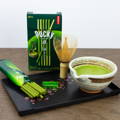WAGASHI - Japanese Sweets For Tea Ceremony
The Japanese tea ceremony is a sacred ritual that calls all participants to leave their ego at the door and to be present in the experience.
Each item, tool and action fosters and inspires an atmosphere of unity and contemplation for everyone involved in the tea ceremony.
Each detail is deeply considered even down to the sweets that are served during the tea ceremony.

What is Wagashi? 和菓子
The general term given to Japanese sweets and desserts is wagashi.
‘Wa’ means Japanese and ‘kashi’ means candy.
Traditional Japanese sweets and desserts are often made from wheat, rice, red beans, soybeans and sugar but as time has passed Japanese sweets have evolved with the influence of the Western world’s dessert customs and the prominent use of eggs and dairy now frequently feature in wagashi recipes.
Today the Japanese sweets and dessert industry is rich with delicious products from mochi, taiyaki, pocky sticks to cotton soft souffle cheesecakes and matcha swiss rolls. Yum!
Sweets also play an important role during a tea ceremony.
Sweets to expand the palate
During a tea ceremony, wagashi are usually served and eaten before the matcha is served.
This is done to develop the sweet receptors in your mouth that will then collide with the savoury vegetal taste of the matcha.
The Japanese have a high regard for combining contrasting flavours that stimulate the taste buds to develop a long-lasting complexity.

Texture adds dimension and pleasure
Traditionally there is an array of wagashi that can be presented at a tea ceremony. Most popular are desserts such as namagashi and yokan.
The wagashi selected for a tea ceremony will have a distinct texture for the guest to experience and enjoy.
Taking a moment to focus on the texture of the wagashi served creates an opportunity for embodiment. To focus on what your taste buds are experiencing and this helps to become more present during the tea experience.
Wagashi textures can vary from dry, chewy, and crispy to moist, soft and gelatinous, they are always a pleasant surprise and joy.

Size does matter
The size of a wagashi presented at a tea ceremony is crucial. They need to be small and are to be consumed in two or three bites.
Being easy to slice through or cut is essential because the sweets should not distract from the tea which is the main element of the tea ceremony experience.
Sweets are also a feast for the eyes
In Japan, it is customary to observe nature and its four distinct seasons. The transient and awe-inspiring power of nature is also reflected during a tea ceremony and especially in the selection of the wagashi presented.
Often the treats are a blaze of colour according to the season or filled with preserved vegetables and fruits that are in abundance during that particular season.
It is common to be served wagashi sweets that are moulded into maple leaf shapes or to be sweetened with seasonal flavours like roasted chestnuts that are symbolic of autumn. Cherry and plum blossoms aromatic and shaped wagashi are extremely popular in spring.
Wagashi served during a tea ceremony is more akin to art and is an opportunity to delight the eyes and senses of smell, not just the taste buds. However, the treats are also prized for their subtle fragrance so as not to overpower the delicate smell of matcha in a tea ceremony.

Delicious sweets in Kyoto
In Kyoto, Japan there is a store called Senbon Tamajuken that makes more than 100 kinds of small delicate Japanese sweets each year. Due to the seasonal availability of produce, sweets sold can be limited but there is always a variety of sweets made each day and each sweet is handmade.
If you are ever lucky to visit Japan and are in Kyoto head to the Tea Room Sentama which is a cafe where you will be served delicious matcha alongside a beautifully presented dessert of your choice.

Delicious Japanese sweets in Sydney and Melbourne
But, if you are like me despite living on the other side of the world, the ritual of having a mindful matcha (alone or with others) with a small treat is always appealing. I crave a little connection to Japan and am thankful for living in Australia where Japanese treats can be easily sourced.
If you live in Sydney and are looking for delicious matcha with something sweet on the side I would recommend Cafe Cre Asion which has a delectable matcha and hojicha swiss roll that can be devoured straightaway or be taken home for a late-night treat. If you are looking for something smaller, Azuki makes a delicious matcha melon pan (a popular Japanese sweet bread) and a matcha azuki pan (another popular sweet bread but this one is filled with a red bean paste).
When looking to serve a crowd-pleasing treat for a group of guests alongside tea it's impossible not to go past Millie Crepe Cakes which is located in Melbourne. They create a heavenly paper-thin matcha crepe cake called Matcha & Adzuki’ that is topped with white chocolate matcha ganache. They also have a very yummy plum yuzu shortcake! This cake has layers of light fluffy sponge, plums and fresh cream that has generous drippings of syrup made from Japanese yuzu.
I am sure if you spend some time googling you too will find some mouthwatering Japanese cafes or desserts inspired by Japanese ingredients near you.
Want delicious and easy Japanese sweets?
Your local Asian grocery is your best bet for finding Japanese sweets. There are also online sellers or you can jump online and see what is available.
We at Purematcha have a small collection of Japanese Sweets that are favourites both here and in Japan.
Glico Matcha Pocky Sticks are becoming more readily available and in my place, the matcha flavour biscuits are always quickly snapped up.
Meiji is also another great quality brand that sells many matcha-flavoured treats. Try their matcha chocolate box, melty kiss matcha chocolate or their rich matcha biscuits.
When it comes to wagashi and tea ceremonies in Japan there has been a long-held tradition.
Sweets help to create opportunities for focus and appreciation. It's a moment to reflect on what we are feeling and how we are responding to others, the seasons, and what we see, smell, feel and taste. A traditional Japanese tea ceremony has several strict protocols which are very thoughtful and purposeful.
Last thoughts
I (like many others) believe we can hold onto the sentiments of a tea ceremony informally at home or out and about. When having a cup of tea at home don’t skip on having a treat and it doesn’t have to be an expensive lavish treat either.
Choose a small treat that visually inspires you due to its shape, colour or texture. Try to ensure it’s not overly sweet so it doesn’t distract from your tea experience but choose a treat with an interesting texture that will awaken your taste buds.
Enjoy having tea and taking some for yourself or connecting with others.










